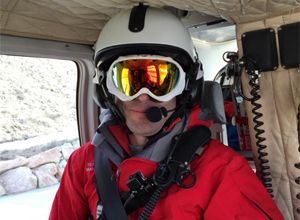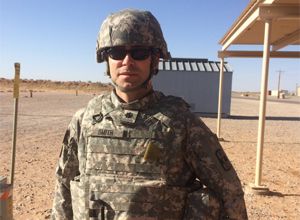Will Smith, with the titles MD and paramedic, is arguably one of the busiest doctors in America.
Along with being an emergency physician at St. John’s Medical Center in Jackson Hole, Wyoming, Smith is the co-medical director for Grand Teton National Park, Teton County Search and Rescue, Bridger-Teton National Forest and Jackson Hole Fire/EMS. You are just as likely to find him responding to EMS and SAR calls in the Jackson Hole and Grand Teton area as you would find him working in the ED.
Dr. Smith also serves as the medical director for the National Park Service, Washington D.C., as well as several other public and private agencies. In addition, Smith is a clinical faculty member at the University of Washington School of Medicine and a Lt. Colonel in the U.S. Army Reserve. He has completed three middle east deployments as well as several other missions around the globe.
Smith was awarded the John P. Pryor Street Medicine Society Award in February. This prestigious award honors a physician who came up through the ranks as an EMS provider and has “demonstrated a sincere and on-going dedication to the betterment of EMS on a regional or national basis through clinical excellence or educational, logistical and/or humanitarian initiatives.”
I spoke with Smith, who is my medical director at Jackson Hole Fire/EMS, to learn more about his impressive career, his thoughts on EMTs and paramedics — what we do well, where we can improve — and his hopes for the future of prehospital care.
How did you get your start in EMS?
I grew up on a 22,000-acre cattle ranch near Wheatland, Wyoming and so I was outside a lot helping my dad. This taught me to have a great deal of personal responsibility, strong work ethic and to be able take care of myself in the middle of nowhere. In my senior year of high school, I took an EMT class and caught the medicine bug. After applying to work for the local ambulance, I found that I was too young to drive the ambulance because I wasn’t 21. So, in order to take ALS calls and get paid, I had to advance to an EMT-Intermediate. Around the same time, I also started doing ski patrol at Snowy Range Ski Area and continued to work my way up the medicine pyramid.
When did you become a paramedic?
I didn’t get into medical school the first year I applied, so I went to paramedic school in Denver through the Colorado Association of Paramedic Education program. Being a flight medic was my backup plan if I didn’t get into medical school.
But the following year, I was accepted and went through the University of Washington regional medical education program which is a partnership between four western states that lack medical schools and the University of Washington. So my first year of school was in Laramie, Wyoming and then I was in Seattle for the second year. The last two years of medical school were in Washington, Wyoming, Alaska, Montana and Idaho.
During medical school, I kept working as a paramedic on weekends with AMR in Cheyenne, Wyoming and Pierce County, Washington and continued to gain a lot of hands-on clinical experience and also got to do a lot of studying when I wasn’t running calls. Between medical school and residency, I couldn’t work as a doctor yet so I went back to Cheyenne and worked full time as a paramedic for five weeks. This was some of my most memorable times on the street with all the additional knowledge I had gained.
How did your experience in working in EMS influence your time in medical school and as a physician?
My prehospital EMS experience definitely set me up to know I wanted to do emergency medicine. The paramedic schooling and my experience in the field also helped me sift through the immense amount of information you get thrown at you medical school. As a paramedic, I was able to say, “OK, that sign or symptom sounds pretty useful,” or that was a case that I saw in the field, so it helped solidify my medical knowledge.
Why do you think it’s important for doctors to experience the prehospital environment?
In most cases, I think there’s a pretty big gap between what happens in the hospital and what occurs in the field. I think having experience in both settings, especially as a medical director, helps me understand what’s going in the prehospital environment and the challenges for EMTs and paramedics.
It’s just not as simple as starting an IV or following the usual treatment algorithms that you’d sometimes do in the hospital. The prehospital setting presents unique challenges. I strongly believe that you have to allow the prehospital providers the latitude and the ability to make the medical decisions balanced with the risk of doing the procedure and the risk of the environment.
This has been most clearly shown with the levels of care in the Tactical Combat Casualty Care guidelines that have emerged from recent military conflicts. These same principles apply to other areas of EMS in technical rescue, wilderness/remote medicine and hazmat scenes.
How did two deployments to Iraq and one to Kuwait with the U.S. Army Reserve influence your care as a physician and the EMS protocols you decide upon as a medical director?
I really saw the benefit of the tourniquet. I got a chance to work in the Baghdad ER for awhile and seeing all the massive injuries — granted, you don’t see those in most EMS settings — but there are definitely those patients where a tourniquet is going to be the one tool to save their life.
I’ve definitely been proactive in implementing protocols and a Rescue Task Force capability based on the Tactical Combat Casualty Care principles here in Jackson Hole and for the National Park Service.
Other key elements are active needle decompression protocols, ketamine use for severe pain — as well as excited delirium, tranexamic acid administration early in severe hemorrhage, as well as escorted warm zone care and casualty collection points for mass violence and other multiple casualty events such as hazardous materials.
What do EMTs and paramedics do really well?
You get the patients from the point of injury to a fixed medical facility and that’s a skillset that is out there and recognized. The recent addition of EMS as a sub-specialty of medicine by the American Board of Medical Specialties clearly recognizes that EMS is a field of medicine with a unique knowledge and skillset.
Now physicians can become board certified in this area and clearly show their knowledge as EMS physicians. EMTs and paramedics are thus an extension of this specialty and the real experts at taking care of patients in these settings. In most cases, throw most non-EMS providers into that world and the same efficiency and positive outcomes generally don’t occur.
What elements of the job could we improve upon?
Like any profession, complacency gets people!
In EMS, you always need to be thinking and planning ahead and preparing for that next step. If a patient deteriorates in the back of the ambulance or in the house and you didn’t bring the right equipment with you, it’s just you and your partner and not a lot whole lot of other resources.
That’s what I like about still practicing in the prehospital realm, it’s a lot more responsibility on me and making sure I have my rapid patient assessment and all my other skills dialed in so I can anticipate problems. I need to have a plan A, plan B and plan C when I am in charge of the crew and, if I am scrambling, it leads to crew breakdown.
The more any of us can prepare streamlines the call and we can take satisfaction when things go right and we are able to save a life.
Despite being a renowned ER doctor, you still keep you paramedic license. Why?
To get your paramedic license is an arduous task. For me, it keeps me grounded in the street because I’ve got to understand the same scope of information and testing materials as my providers. I feel that as a medical director, if I’m able to keep my own skill set up, then I can help prepare my providers and know what they are doing in the field.
Where do you see EMS going in the future?
EMS is still a relatively young specialty coming from the ‘70s. We’ve come a long way but there’s a lot more growth that EMS has yet to come. The community paramedicine programs are starting to blossom and really show a much greater potential for the prehospital world.
It’s not just the trauma patients who need to get to the hospital for their definitive surgery but it’s also the ongoing care of some of our public health issues like alcoholism and congestive heart failure.
And as we start getting into domestic terrorism and active shooter events, there are a lot more interventions that EMS is able to perform at the point of injury that can clearly save lives.
Lastly, getting into the emerging infectious disease categories, you don’t want to take these patients to a central location and get everyone else infected. I think EMS still has a lot of growth potential for remote care.
How would you recommend EMS providers avoid complacency?
I recommend life-long continued learning. Some great references are trade websites and publications. EMS providers should also read peer-reviewed academic journals such as Prehospital Emergency Care and other journals that commonly publish articles that are directly relevant to EMS.
If you are really a go-getter, then help perform the research and answer questions about how best to treat a certain condition.
We know that much of what we initially learned in EMS over the past 10 to 20 years is now changing based on new research. Shifts in treatment paradigms continue to challenge what we do on a daily basis and all these things we thought were best for our patients when, actually, we were probably doing some harm.
Why is the John P. Pryor Award award important to you?
Both personally and professionally, being recognized for the work I’ve done locally, regionally, nationally and internationally has been great. But I also personally knew Dr. Pryor and worked with him on my first Iraq deployment. He was a trauma surgeon and I was an ED physician and we just clicked so well and got to be good friends. On our second Iraq deployment, we were in different locations when he was killed. It’s a humbling experience and honor to be given that award in his name.
Any last advice for EMTs and paramedics out there?
Do what’s right for the patient. We often feel constrained by so many conflicting factors when trying to deal with a patient. But just remember why you are there.
To learn more about Dr. Will Smith’s medical experiences, consulting services and upcoming lectures, please visit: http://www.wildernessdoc.com













